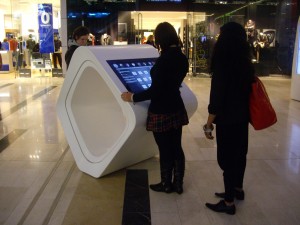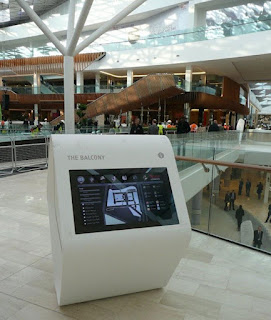WAYFINDING
Contemporary sign system
Wayfinding encompasses all of the ways in which people orient themselves in physical space and navigate from place to place. In more modern times, it has been used in the context of architecture to refer to the user experience of orientation.
As part of my second task of “Wayfinding” at Critical debates in Design, I have chosen to evaluate the Westfield shopping center wayfinding system. At the end of 2008, the Westfield Shopping Centre (Shepherds` Bush, London) was opened, an indoor shopping centre whose dimensions in area and exploitation potential can only be described as ‘spectacular’. It was the largest urban shopping centre ever, a city within a city. You can also find banks and pharmacies there, as well as cinemas and restaurants, whose international diversity offers a vast selection to satisfy the tastes of its visitors.
The internal life of this empire of progressive experience offers an enormous wealth of shopping and recreational possibilities, to include spas, sports and culinary facilities. Westfield integrates exclusive designer boutiques and fashion shops with supermarkets and dry cleaning stores, all under one roof. While researching I have found out that Westfield commissioned PearsonLloyd to deliver a unified concept for all the on-mall messaging and signage which included static wayfinding, digital signage, concierge reception desks and interactive wayfinding information points. They were provided and technically implemented by Rosskopf & Partner. Due to its optimum possibilities of translucence and thermal shaping, solid surface material was selected for manufacturing all of these elements. The ingenious results in forming these exceptional objects can be seen throughout the centre. Individual objects were designed that called for progressive solutions that previously had never been produced in this form anywhere in the world. The unique organic shapes conceived by PearsonLloyd were fabricated from LG Hi-Macs by world leading manufacturers Rosscopf and Partner AG with the Concierge Reception desks actually being fabricated on site.
10 Squared were commissioned by Westfield to modify the conceptual designs of the Interactive Rings to ensure that form did not compromise function and then to design, manufacture and install the touch screen technology module. In all, 32 interactive screens were installed including the 4 screens on the Concierge Reception Desks. Each screen is direct sunlight viewable and in order to provide the highest possible screen clarity is glass bonded, which has the added benefit of making the screen incredibly rugged.
The idea, aesthetic, choice of materials and technical implementation of innovative ideas were translated into formats that are best described as ‘avant-garde’. On the other side, except the futuristic forms unseen before (for me) I can say that the system of orientation and digital map screens there show us how sophisticated is the way of communication and how their client-connection is established. However, while this contemporary sign system does his job very well, I think that sometimes there is not enough information and I can find it a bit confusing to find the displays in such a big mall. Even though that at the beginning the wayfinding system may not be familiar with all ages, which may have trouble finding them due to size of the facility in general and problems to navigate due to some of their digital forms, I think that this system has brought some new standards of modern signage, image and communication.
References:
http://www.rosskopf-partner.co.uk/case-studies/westfield-shoppingcentre/benoy-international-architects/ http://www.rosskopf-partner.co.uk/case-studies/westfield-shoppingcentre/westfield-group/
http://www.10squared.co.uk/westfield.htm
http://en.wikipedia.org/wiki/Wayfinding
Contemporary sign system
Wayfinding encompasses all of the ways in which people orient themselves in physical space and navigate from place to place. In more modern times, it has been used in the context of architecture to refer to the user experience of orientation.
As part of my second task of “Wayfinding” at Critical debates in Design, I have chosen to evaluate the Westfield shopping center wayfinding system. At the end of 2008, the Westfield Shopping Centre (Shepherds` Bush, London) was opened, an indoor shopping centre whose dimensions in area and exploitation potential can only be described as ‘spectacular’. It was the largest urban shopping centre ever, a city within a city. You can also find banks and pharmacies there, as well as cinemas and restaurants, whose international diversity offers a vast selection to satisfy the tastes of its visitors.
The internal life of this empire of progressive experience offers an enormous wealth of shopping and recreational possibilities, to include spas, sports and culinary facilities. Westfield integrates exclusive designer boutiques and fashion shops with supermarkets and dry cleaning stores, all under one roof. While researching I have found out that Westfield commissioned PearsonLloyd to deliver a unified concept for all the on-mall messaging and signage which included static wayfinding, digital signage, concierge reception desks and interactive wayfinding information points. They were provided and technically implemented by Rosskopf & Partner. Due to its optimum possibilities of translucence and thermal shaping, solid surface material was selected for manufacturing all of these elements. The ingenious results in forming these exceptional objects can be seen throughout the centre. Individual objects were designed that called for progressive solutions that previously had never been produced in this form anywhere in the world. The unique organic shapes conceived by PearsonLloyd were fabricated from LG Hi-Macs by world leading manufacturers Rosscopf and Partner AG with the Concierge Reception desks actually being fabricated on site.
10 Squared were commissioned by Westfield to modify the conceptual designs of the Interactive Rings to ensure that form did not compromise function and then to design, manufacture and install the touch screen technology module. In all, 32 interactive screens were installed including the 4 screens on the Concierge Reception Desks. Each screen is direct sunlight viewable and in order to provide the highest possible screen clarity is glass bonded, which has the added benefit of making the screen incredibly rugged.
The idea, aesthetic, choice of materials and technical implementation of innovative ideas were translated into formats that are best described as ‘avant-garde’. On the other side, except the futuristic forms unseen before (for me) I can say that the system of orientation and digital map screens there show us how sophisticated is the way of communication and how their client-connection is established. However, while this contemporary sign system does his job very well, I think that sometimes there is not enough information and I can find it a bit confusing to find the displays in such a big mall. Even though that at the beginning the wayfinding system may not be familiar with all ages, which may have trouble finding them due to size of the facility in general and problems to navigate due to some of their digital forms, I think that this system has brought some new standards of modern signage, image and communication.
http://www.rosskopf-partner.co.uk/case-studies/westfield-shoppingcentre/benoy-international-architects/ http://www.rosskopf-partner.co.uk/case-studies/westfield-shoppingcentre/westfield-group/
http://www.10squared.co.uk/westfield.htm
http://en.wikipedia.org/wiki/Wayfinding


















